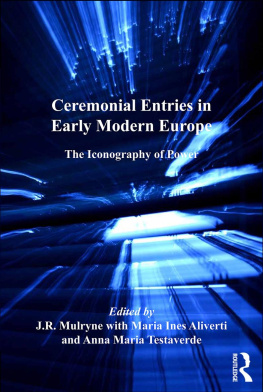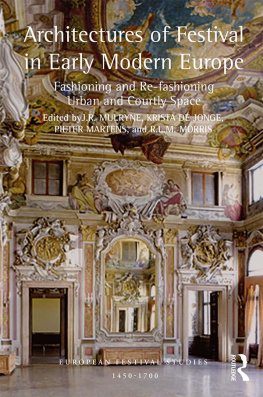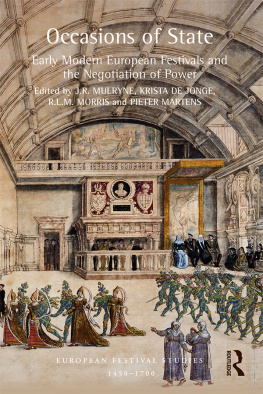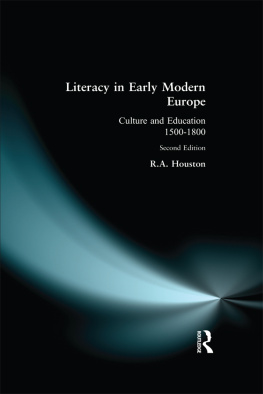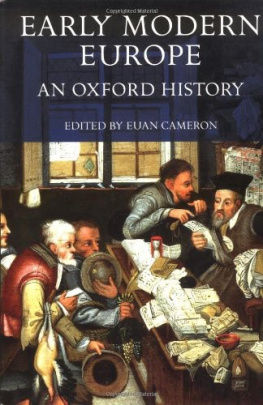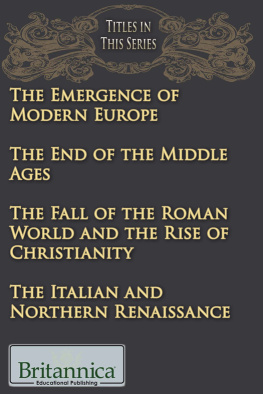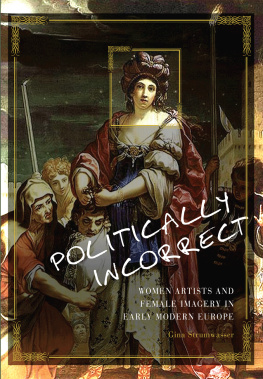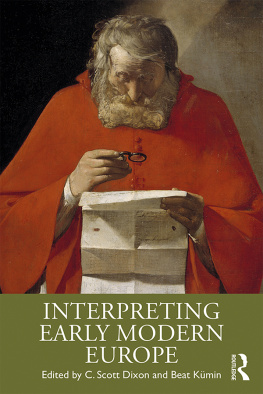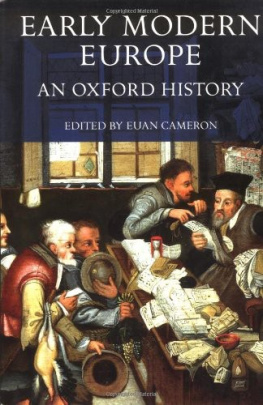CEREMONIAL ENTRIES IN EARLY MODERN EUROPE
European Festival Studies: 14501700
Series Editors:
J.R. Mulryne, University of Warwick, UK
Margaret Shewring, University of Warwick, UK
Margaret M. McGowan CBE, FBA, University of Sussex, UK
This series, in association with the Society for European Festivals Research, builds on the current surge in interest in the circumstances of European Festivals their political, religious, social, economic and cultural implications as well as the detailed analysis of their performance (including ephemeral architecture, scenography, scripts, music and soundscape, dance, costumes, processions and fireworks) in both indoor and outdoor, urban and court, locations.
Festivals were interdisciplinary and, on occasion, international in scope. They drew on a rich classical heritage and developed a shared pan-European iconography as well as exploiting regional and site-specific features. They played an important part in local politics and the local economy, as well as international negotiations and the conscious presentation of power, sophistication and national identity.
The series, including both essay collections and monographs, seeks to analyse the characteristics of individual festivals as well as to explore generic themes. It draws on a wealth of archival documentary evidence, alongside the resources of galleries and museums, to study the historical, literary, performance and material culture of these extravagant occasions of state.
Ceremonial Entries in Early Modern Europe
The Iconography of Power
J.R. MULRYNE
University of Warwick, UK
with
MARIA INES ALIVERTI
University of Pisa, Italy
ANNA MARIA TESTAVERDE
University of Bergamo, Italy
First published 2015 by Ashgate Publishing
Published 2016 by Routledge
2 Park Square, Milton Park, Abingdon, Oxon OX14 4RN
711 Third Avenue, New York, NY 10017, USA
Routledge is an imprint of the Taylor & Francis Group, an informa business
Copyright J.R. Mulryne 2015
J.R. Mulryne has asserted his right under the Copyright, Designs and Patents Act, 1988, to be identified as the editor of this work.
All rights reserved. No part of this book may be reprinted or reproduced or utilised in any form or by any electronic, mechanical, or other means, now known or hereafter invented, including photocopying and recording, or in any information storage or retrieval system, without permission in writing from the publishers.
Notice:
Product or corporate names may be trademarks or registered trademarks, and are used only for identification and explanation without intent to infringe.
British Library Cataloguing in Publication Data
A catalogue record for this book is available from the British Library
The Library of Congress has cataloged the printed edition as follows:
Ceremonial Entries in Early Modern Europe: The Iconography of Power / edited by J.R. Mulryne with Maria Ines Aliverti and Anna-Maria Testaverde.
pages cm. (European Festival Studies: 14501700)
Includes bibliographical references and index.
1. Ceremonial entries Europe History. 2. Processions Europe History. 3. Rites and ceremonies Europe History. 4. Royal visitors Europe History. 5. Power (Social sciences) Europe History. 6. Europe Social life and customs. I. Mulryne,
J. R., editor of compilaton.
GT4042.C47 2015
394.2094dc23
2014023592
ISBN 9781472432032 (hbk)
ISBN 9781315571140 (ebk-PDF)
ISBN 9781317168904 (ebk-ePUB)
Contents
J.R. Mulryne
Richard Cooper
Linda Briggs
Margaret M. McGowan
Marie-Claude Canova-Green
Anna Maria Testaverde
Lucia Nuti
Iain Fenlon
Julia de la Torre Fazio
Veronika Sandbichler
Jacek ukowski
Margaret Shewring
Sara Trevisan
Lucinda H.S. Dean
Andrea Sommer-Mathis
Acknowledgements
This third volume of the Ashgate European Festival Studies series takes its origin, like the two which preceded it, from a conference organised by the Society for European Festivals Research, taking place on this occasion at the Convento di SantAgostino of the Universit degli Studi di Bergamo in May 2012. The conference title, The Iconography of Power: Ceremonial Entries in Renaissance and Early Modern Europe, has been no more than marginally adapted as the title of this volume.
Organising conferences and publishing research essays deriving from them not conference proceedings are activities demanding a great deal of time, commitment and knowledge. I am especially grateful in the case of the present volume for the work, in all three respects, of Anna Maria Testaverde, Associate Professor in the Department of Humanities of the Universit degli Studi di Bergamo and Maria Ines Aliverti, formerly Associate Professor in the Department of History of Art at the Universit degli Studi di Pisa, both of whom have continued their pre-conference and in-conference work by giving assistance as Advisory Editors of this volume. I am grateful to Linda Briggs, then of the University of Warwick, for her assistance during and before the conference, especially in relation to graduate and early career contributors, an aspect of the Societys work to which we are strongly committed. It is a pleasure to thank, also, Melanie Zefferino, a qualified and experienced curator, who has recently completed her doctoral research at the University of Warwick and who was untiringly helpful to us in many practical ways. The assistance of many libraries, galleries and archives is formally noted in the List of Illustrations in this volume, and their copyright ownership stated. Especial thanks are due to Margaret Shewring of the University of Warwick, a co-Convenor of the Society and editor of the second volume of the Festival Studies series, whose outstanding generosity in contributing to the Societys activities and in securing academic and financial support for our work has become indispensable. Margaret has been, once again, of irreplaceable assistance in preparing copy for the publication of this book.
Holding the conference in the beautiful Renaissance city of Bergamo and the universitys Convento SantAgostino was in itself an apt inspiration for scholarship and conviviality. We are happy to acknowledge the generous support of our hosts, the Universit degli Studi di Bergamo and of the Universitys Magnifico Rettore, Professor Stefano Paleari. We are grateful in addition for financial and academic support from the University of Warwick (Humanities Research Fund, Humanities Research Centre, Institute for Advanced Studies, Renaissance Studies and Theatre Studies) and from the Universit di Pisa, as well as, once again, the Societys publishers, Ashgate Publishing Ltd, who hosted a very welcome conference wine reception.
If conferences and published volumes are to be successful they have to be models of team work. I am grateful to all contributors to this volume, who have been patient and co-operative with my sometimes intrusive editing, and who have in most cases cheerfully met what must have seemed arbitrarily imposed deadlines, and observed stylistic and reference criteria which must in numerous instances have seemed alien. I am also grateful to several scholars whose work is not included in this volume but who gave papers and/or greatly assisted conference members with comment, advice and research suggestions. Among these were Professors Sydney Anglo, Bernardo Garcia Garcia, Cristina Grazioli, Paulette Chon, Franca Franchi, Dr David Sanchez Cano and Mr Richard Morris.


